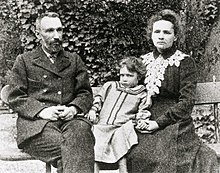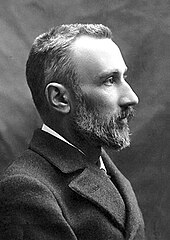Pierre Curie
Pierre Curie (born May 15, 1859 in Paris ; † April 19, 1906 there ) was a French physicist and Nobel Prize winner .
Life


Pierre Curie was born in Paris as the second son of the doctor Eugène Curie and the daughter of a manufacturer, Sophie-Claire Depouilly. He was taught by private tutors and graduated from high school at the age of 16. At the age of 19 he earned a university degree in physics . As a result, Curie was appointed teacher at the School of Physics and Chemistry in Paris, which he took over in 1882. He completed his doctorate in 1895 and was appointed professor. In 1900 Curie became a teacher at the École polytechnique . In 1905 he became a member of the Académie des Sciences .
On July 26, 1895, he married the Polish physicist Maria Skłodowska (later known as Marie Curie), with whom he had two daughters: Irène and Ève .

Pierre Curie died in Paris on April 19, 1906 at the age of 46 in a traffic accident when he got under a horse-drawn vehicle and suffered a fractured skull.
On April 20, 1995, the remains of Pierre and Marie Curie were transferred to the Panthéon with a state funeral .
Services

In his early studies of crystallography , which he carried out with his older brother Jacques , he discovered piezoelectricity in 1880 . Further work on symmetry turned his attention to the field of magnetism . In doing so he discovered the Curie temperature and the Curie law . The Curie constant is also named after him.
Together with his wife Marie, he discovered radium and polonium as decay products of the radioactive isotope uranium-238 contained in pitchblende . In 1903 he and his wife Marie Curie received half of the Nobel Prize in Physics for “their joint work on the radiation phenomena discovered by H. Becquerel”. The second half of the award went to Henri Becquerel .
Fonts (selection)
- Marie and Pierre Curie: The new radioactive substances and their radiation . 1900
- Marie and Pierre Curie: About the radioactive bodies . 1901
- Pierre Curie and Henri Becquerel: Physiological Effects of Radium Rays . 1901
- Pierre Curie: About the absolute measure of time . 1902
- Oeuvres de Pierre Curie . 1908; on-line
Awards
- Davy Medal , Royal Society , 1903
- Nobel Prize in Physics , 1903
- Elected to the Academy of Sciences, 1905
- The chemical element curium with atomic number 96 was named in honor of the married couple Pierre and Marie Curie.
- Together with his wife, he is the namesake for the Curie Island in the Géologie archipelago off the coast of the East Antarctic Adélieland. According to him alone and is Curie Point named a headland of Doumer Island in the Palmer Archipelago West Antarctic.
- The lunar crater Curie is named after him.
literature
- Eve Curie: Madame Curie , Vienna 1937, ISBN 3-596-22243-5
- Manfred Jacobi: Pierre Curie - a life dedicated to research. Physics in Our Time 37 (3), pp. 116-121 (2006), ISSN 0031-9252
Web links
- Information from the Nobel Foundation on the 1903 award to Pierre Curie
- Acknowledgment from the American Institute of Physics
- Literature by and about Pierre Curie in the catalog of the German National Library
Individual evidence
| personal data | |
|---|---|
| SURNAME | Curie, Pierre |
| BRIEF DESCRIPTION | French physicist and Nobel Prize winner |
| DATE OF BIRTH | May 15, 1859 |
| PLACE OF BIRTH | Paris |
| DATE OF DEATH | April 19, 1906 |
| Place of death | Paris |

